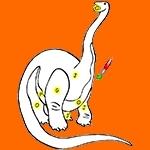
 |
Number Paint |
This game is an old favourite. It involves colouring an outline picture by matching symbols. In this case those symbols are shapes, numbers 0 to 9 and letters of the alphabet.
On entering the game a picture will appear on the main part of the screen.
The object of the game is to colour the picture, matching the symbols to those on the paint pots.
The pointer appears as a paintbrush, but turns into a pointing finger when over the toolbar icons.
Click on the pots to select them. The bristles on the brush will change to that colour. The tip of the brush is the active part of the pointer. So to activate; this must be within the area to be painted.
When a picture has been completed, a fanfare will sound and a new one will appear. The symbols to be used will be chosen randomly by the program.
Difficulty levels correspond with the number of paint pots. At level one there are three pots and at level four there are six.
Levels can be changed at any time. The design will stay the same, but more paint pots will be available for use. Symbols may also change.
To exit, click on the exit icon in the lower right corner.
Outcome 4: Children are involved and confident learners
Outcome 5: Children are effective communicators
Shape recognition - basic and more complex
Colours
Numbers 0 to 9
Upper case letters
Lower case letters
Same and different recognition
Observation
Concentration
Mouse control - single click
It is interesting to see that children tackle these sorts of activities in different ways. Some will choose a paint pot and methodically search through the design for all the areas with the same symbol. Others will work from the design, changing pots as they come across a new symbol to match. Both methods will work. Encourage children to use the one they enjoy the most.
Children may tend to choose a paint pot and then click on any area until they find one that stays coloured. Encourage them instead to look for the symbol that appears on the paint pot. Compare the colour on the tip of the brush to the pot and its symbol. Symbols are chosen randomly for each game. If a child would like to focus on a particular type of symbol, they can click on the difficulty level until they find one that suits.
Ask children to say out loud the name of the symbol they are going to target. This helps them to remember the task and reinforce the learning process.
Some of the areas to be painted are small and children may have some difficulty. Help by reminding them that the tip of the brush must be over the white area to be coloured.
More complex shapes have been used in this game. These are pentagons, hexagons, octagons, hearts, arrows and diamonds. Even though some of the names are a bit tricky, encourage children to say them as they look for them in the design. They will be soon able to recognise and name them independently.
Little fingers get incredibly dirty; just have a look at the marks left on walls and doors around your room. Thankfully, steps can be taken to protect computers from grime and dirt.
Ask children to have a look at their hands before using the computer and give them a quick wash if they are obviously sticky or dirty. Sand, food particles, spreads such as jam and honey can be very difficult to remove from hardware (keyboards especially).
It is probably impractical to ask preschoolers to wash their hands every time they are about to jump on the computer. Some will, but most won't. Hand wipes placed near the computer may remind children to give their hands a quick clean before they sit down. Tissues in a handy spot are also a good idea for unexpected sneezes and runny noses.
Ask children not to touch the computer screen too much. Touching the computer screen will lead to a build up of grease and dirt. As grime gradually builds up we often do not notice, but complain that the image on the screen seems darker or blurred. Not until we see the difference cleaning the screen makes, do we realise how dirty it was.
Keyboards, screens and mouses can be wiped with a damp cloth to remove dust and dirt. Avoid directly spraying cleaning liquid onto computer parts. Apply firstly to a clean, lint free rag and then gently wipe the screen etc. A soft paintbrush can be used do remove particles from between keyboard keys.
Eating or drinking while using a computer should be discouraged, for both adults and children. Spillage onto electrical equipment can be disastrous and dangerous. Crumbs can be very difficult to remove from the many nooks and crannies associated with computers and may adversely affect the machine's function.
Screens can be protected by using a clear plastic protector, which can be removed and washed with warm, soapy water. Make sure they are dried fully before placing back over the screen. This is particularly useful with younger children who impulsively touch the screen while they are playing their favourite games.